
MAY CONTAIN NUTS

Search Shorpy
SHORPY ART

Framed or unframed, desk size to sofa size, printed by us in Arizona and Alabama since 2007. Explore now.
Join and Share
Ad-Free Shorpy
Shorpy is funded by you. Patreon contributors get an ad-free experience.
Learn more.

Recent comments
- Recent view
- Hudson’s Big Store
- Say what??
- Grapes?!
- A Beautiful Moment
- Such joy
- Bethune-Cookman University today...
- Yellow sky at morning
- Side Winder
- Air Quality?
- Sojourner Truth riot
- None were so blind(ed)
- The less famous sister
- Good ol' days?
- Rise and Fall
- Goo Goo Ga Joob
- Ticket Retention
- Not the only one
- Vagaries of War
- Killed by Amtrak
- Back to the Future
- Wanted --
- If you can't stand the light
- Centralized Traffic Control, I believe
- What's really happening
- Heckuva remote control!
- Sometimes — Things Go Bump!
- I SEE THE LIGHT
- Union Switch and Signal Company
- Get That Light Out Of My Eyes
Member Photos
The Shorpy
Print Emporium
Print Emporium
Search Shorpy
Search results -- 30 results per page
- The Vacationist: 1942
- ... size.
Sketchy rig The only thing holding that boat on the car is the 35MPH speed limit.
Gone Fishing Nicely ... "Special Deluxe Club Coupe".
Proof There was a boat on there when we left.
(The Gallery, Boats & Bridges, Cars, Trucks, ... Posted by Dave - 10/30/2020 - 12:49am -
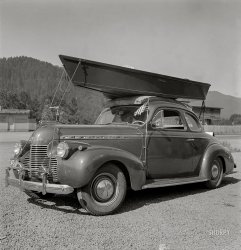
- Good EAT Food: 1938
- ... a fish market. You buy from shops instead of right off the boat.
I beg to differ I respectfully disagree with MaltedFalcon on ... Posted by Dave - 02/17/2015 - 9:42pm -
![Good EAT Food: 1938 January 1938. Washington, D.C. "Cafe on L Street." Where the only thing flakier than our delicious biscuits is the peeling paint! 35mm nitrate negative by Russell Lee for the Resettlement Administration. View full size.
Price Gouging25-cents is way too much to pay for chitterlings. Especially if you can get a Fish Sandwich for a dime.
Inscription on doorWhat is the writing that appears on the door? It looks Arabic.
[1841. And indeed, they are Arabic numerals! -Dave]
Questionable syntaxPut me immediately in mind of our trip to Kyoto, where we'd breakfast in a cafe called "Good Eat You".
We'd joke about putting in a reservation for Donner: "Donner, party of five . . . party of four . . . party of three . . . "
Making me hungryLiver & onions for a quarter?? Make it a double and add some mashed w/dark lumpy gravy and string beans. I'll be back tomorrow for the fried chicken!
Panoramic viewA quick stitching and we get a better view of this old building full with character.
Chincoteague oysters"1/2 dozen oysters 35 cents" ... nowadays a half-dozen Chincoteague oysters runs about $6.
This was probably L Street in SE Washington, about 200 feet from the Anacostia River.
When I was a kid my dad would stop by the wharf and buy fresh shucked oysters in big mason jars from the boats at water Street SW. Now it's turned into a fish market. You buy from shops instead of right off the boat.
I beg to differI respectfully disagree with MaltedFalcon on the location of this photo. I don't believe this can be in SE because, well, L St. SE doesn't run past 17th St. (and never has).
No, I think this has to be 1841 L St. NW. That seems to match the 1921 Baist atlas, which shows two frame structures with a narrow side yard to the east (which we see in the companion photo of the shoe store). Even though the photo above is from a later decade, it seems likely that the building in question has been there, slowly deteriorating, since well before 1921.
1957 Baist's Real Estate AtlasThe 1940 Boyd's City Directory shows 1841 L St. NW to be "Tate Louis restr", which would be a restaurant owned by Louis Tate. Also there by the same name in the classified section.
Things were different by 1957, as shown by the Baist's Real Estate Atlas of that year. Street address 1841 is now assigned to the buildings in lots 937 and 1038. There's a gas station on the corner, with a building set back from the street, like the building with the "Independent" sign in the picture.
1845 L St. NW was a filling station in the 1940 Boyd's City Directory.
(The Gallery, D.C., Eateries & Bars, Russell Lee)](https://www.shorpy.com/files/images/SHORPY-8a22615a.thumbnail.jpg)
- Harbor Springs: 1906
- ... Spray It appears that Julie Andrews just missed the boat. Which, if my very limited research is worth anything - and it may very ... to the Little Traverse Bay area in 1903. Lincoln Park Boat Line of Chicago acquired her about 1911, and she met her end on there on ... Posted by Dave - 09/05/2014 - 12:13pm -

- Battleship: 1905
- ... - Dave]
Rather Inefficient With all the time that boat spent underwater, they should have just built it as a submarine.
(The ... Posted by Dave - 09/14/2011 - 6:24pm -
![Battleship: 1905 October 22, 1900. "Russian warship Retvizan, day before launching, Cramp's shipyards, Philadelphia." This battleship had its ups and downs -- built for the Imperial Russian Navy, torpedoed during the Russo-Japanese War, refloated, then sunk, then raised, then commissioned in the Japanese Navy, then sunk again. Whew. 8x10 inch glass negative, Detroit Publishing Co. View full size.
Cramp's style (sorry)From Philaplace (with 27 very nice images from late 1800s-1943)):
The Cramp shipyard, founded in 1830 by William Cramp, actively participated in the modernization of the shipbuilding industry, from a craft mode of production focused around wooden sailing vessels to an industry centered around steam engines and iron and steel construction. At its height during World War II, it employed roughly 18,000.
Teak BackingThis photo gives an extremely rare view of the wood backing through which heavy armor plate was attached on most armored ships before World War II. (The latest armored ships used concrete as the backing material).
It was established in the Civil War period that a wooden backing helped to distribute the shock of a hit on the armor, and teak was selected by most navies as the best material. As armor technology evolved, the surface was case hardened by a number of different processes depending on what facility did the work. This surface was so hard and brittle it could accept no fasteners, and therefore, holes had to be cut part-way into the armor from the back and threaded rods inserted into them. The armor plates were hoisted into place with a crane, very carefully sliding the rods into corresponding holes in the backing and the ship's structural plating behind them.
You can see the wooden planks -- that's the backing -- in way of the armor belt at the loaded waterline that hasn't yet been applied, and the holes already made to accept the rods. Once the armor was in place, washers and nuts had to be screwed onto the ends of the rods that would be showing inside the hull plating to hold the armor in place.
Wikipedia says the armor belt was 9 inches thick and was US-made, but according to Krupp's process.
XXVThose pesky 'Roman Numerals' again. Still can't understand why we stopped using them all the time; they're so clear and easy to understand.
ArmorThe wood backing also acted the same way as a "splinter deck" absorbing the razor sharp steel splinters that would be propelled outward from the point of impact literally shredding anyone or thing in its path.
Day before launching?How on earth would this ship be ready to launch the next day? There looks to be a whole lot of work remaining. There isn't even a superstructure yet, nor has the hull been finished being armored.
They have a long day ahead of them!
[A lot of that gets done after launching. - Dave]
Rather InefficientWith all the time that boat spent underwater, they should have just built it as a submarine.
(The Gallery, Boats & Bridges, DPC, Philadelphia)](https://www.shorpy.com/files/images/4a08488a.thumbnail.jpg)
- Pier 42: 1920
- ... to the Pacific Mail Steamship Co.
The lapstrake boat lying on the sidewalk appears to be a double-ender with rowing seats, likely a ship's boat or lifeboat. It does not seem to be treated with the TLC due to a ... Posted by Dave - 03/04/2015 - 6:36pm -
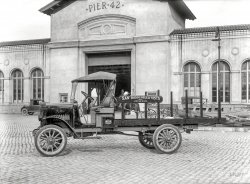
- Oldsmobile Home: 1950s
- ... of the photo. The car is a 1957 Oldsmobile. Also note the boat in the building. 35mm color slide. View full size.
Rocket 88 ... Posted by shawnv - 02/11/2012 - 12:28pm -
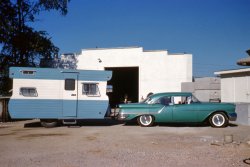
- Mermaid on Skis: 1953
- ... it should recover I hope. I wonder if the electric boat ride through the botanical gardens is still there. Of course, the pool ... Posted by Dave - 11/17/2015 - 6:44pm -
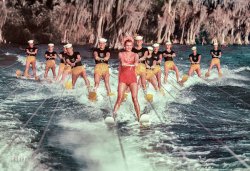
- Chili in Cleveland: 1905
- ... and includes exhibits and a very nice restored lake boat (ie a large freighter) to tour.
Many ports on the Great Lakes have ... (lake freighter photos + artifacts), Duluth (a lake boat to tour), etc.
(The Gallery, Boats & Bridges, Cleveland, DPC) ... Posted by Dave - 04/06/2016 - 8:53am -
![Chili in Cleveland: 1905 Lake Erie circa 1905. "Freighters Chili & Wm. Castle Rhodes at Cleveland." After half a century of service that included a number of sinkings, groundings and collisions, the Chili (renamed the Sarnian in 1913) was scrapped in 1944. 8x10 inch dry plate glass negative, Detroit Publishing Co. View full size.
The ChiliFrom the Great Lakes Maritime Database there is a clearer view of the vessel's name on the wheelhouse. However, the name on the stern still looks like "CHILL" in that pic. also.
[There's a period after the "I" -tterrace]
It's "THE CHILL"The tail on the 2nd "L" is obscured by the ladder.
[Chili. -tterrace]
Another Great Lakes vessel databaseThere is at least one other large Great Lakes vessel database. This other one is at Bowling Green State University (Ohio) They appear to complement each other. Their entry for the Chili.
The BGSU collection is open to researchers, and it is common for someone with interest in lake boats to spend a day or several days there.
Additionally, the marine museum that was in Vermilion OH has moved to Toledo, and includes exhibits and a very nice restored lake boat (ie a large freighter) to tour.
Many ports on the Great Lakes have worthwhile marine museums, such as Buffalo (Navy ships), Erie (primarily early sail history, and the Battle Of Lake Erie), Ashtabula + Fairport Lighthouse (lake freighter photos + artifacts), Duluth (a lake boat to tour), etc.
(The Gallery, Boats & Bridges, Cleveland, DPC)](https://www.shorpy.com/files/images/SHORPY-4a25401a.thumbnail.jpg)
- Noble Riggers: 1905
- ... a sense of growing importance.”
Sadly, the last boat sailed in 1957.
Does your mother still dress you? Can anyone fill ... Posted by Dave - 10/02/2018 - 2:25pm -
![Noble Riggers: 1905 Detroit circa 1905. "Belle Isle ferry dock." A good place to pick up a yacht sail. The steamer Garland, seen earlier here. 8x10 glass negative. View full size.
Stove burnedThe giant Garland stove you remember was made of carved oak. It was moved from near Belle Isle to the state fairgrounds off 8 Mile in 1965. In 1974 it was disassembled and stored, but then was refurbished and returned to the fairgrounds in 1998.
In Aug. 2011, it was struck by lightning and burned.
Belle Isle from CanadaI grew up in Riverside (now Windsor) Ontario in the 1950s, and we lived on Esdras Place, just one block from the Detroit River. At the foot of Esdras there is a private park owned by the residents, and it looks directly across the river to Belle Isle. There were many kids on the block then, and that is where we learned to swim. There were picnics and parties held there though the summer.
The Kodachrome photo was taken by my father in 1955, and shows residents swimming in the river, with Belle Isle on the far side. The freighter steaming past is the Ralph Budd, which had an interesting history.
A sign in the 1906 photo indicates service to Bois Blanc, on June 7. It was also known as Bob-lo Island, downstream from Detroit. You can read more here.
"Naming rights"existed even in 1880, when the Garland was built, reportedly the first electrically-lit vessel on the lakes. She was named for the most popular model manufactured by Detroit's Michigan Stove Company; in return, the vessel's owner, Captain John Horn, had his new craft festooned in nickle-plated decoration, courtesy of the stove manufacturer. Indeed, the odd-looking mass ahead of the funnel is an example of that handiwork, a garland with the letter "G" inside. When I was a kid a gigantic Garland stove, at least two stories tall, dominated the approach to Belle Isle at Detroit, built for Chicago's Columbian Exposition. For all I know, it's still there.
The Garland endured quite awhile. Horner lost the vessel after the tragic accident involving mostly altar boys, referred to in the comments to Shorpy's original view of the ferry, when her builder, the Detroit Dry Dock Company, repossessed it. She continued in the Detroit-Sarnia service, renamed City of Sarnia in 1923, until removed from service in the early 1940s. She sank at the dock in 1945, and was dismantled in situ 1946-47.
Giggle, Giggle!One can almost hear the gleeful titters of the little girls in their summer frocks and straw hats, about to embark on an exciting voyage to exotic and storied foreign climes. Well, maybe those lands are still in the US and just across the river, but when you're five or ten, opportunities like this take on exciting aspects out of all proportion to the way adults reckon these things.
This is a view of the ferry dock at the foot of Woodward AvenueSure, you could travel a few miles down Jefferson Avenue and cross to the Island over a bridge, but for a dime you could cruise there in style on the Garland or its sister vessel, which began ferry service when Belle Isle opened in 1882.
In their 1957 book Made in Detroit, Norman Beasley and George W. Stark describe the allure of the steamers: “All day long until late at night, the Belle Isle ferries traveled up and down the river. … The fare was ten cents, and if the passenger so chose he could ride all day long for his original dime. … In the dusk of evening, the ride back to the city was exhilarating. The lights in the scattered high towers gave dimensions to Detroit; the growing skyline gave a sense of growing importance.”
Sadly, the last boat sailed in 1957.
Does your mother still dress you?Can anyone fill me in on why that one boy seems to be wearing a doily on his shoulders? This is not something that I have seen before, and I am wondering if it is a common article of clothing. It occurs to me that his mother might have thrown that over his shoulders as a sort of shawl anticipating cooler temperatures out on the water. Can anyone shed any light on this for me?
[Appears to be a kind of Fauntleroy suit. - tterrace]
June 7, 1906?Possibly circa on or shortly before June 7, according to the displayed timetable. Can't make out what the two words to the left of "June 7" are. "Best Blues"?
Bois BlancThe sign actually says "Bois Blanc" referring to another island in the Detroit River also known as Boblo Island.
(The Gallery, Boats & Bridges, Detroit Photos, DPC)](https://www.shorpy.com/files/images/SHORPY_4a16323a.thumbnail.jpg)
- Vis-O-Matic: 1950
- ... wheel used to flip the Rolodex looks big enough to turn a boat! It must have been for show, because current Rolodexes use a much smaller ... Posted by Dave - 11/28/2008 - 3:58pm -
![Vis-O-Matic: 1950 June 6, 1950. "Vis-O-Matic department store," a premonition of virtual retailing. One of at least 200 photographs taken by Bernard Hoffman at retail magnate Laurence Freiman's newfangled catalog store in Pembroke, Ontario. The cards were an index of merchandise on color slides viewed by customers on rear-projection screens. Life magazine image archive. View full size.
Jaunty ChapeauI imagine it must have taken tons of pins to keep that hat on her head. Could also be contributing to the expression of tooth-grit pleasantry.
Pembroke, Ont.Pembroke is such a sleepy little town. With a lot of history. It's hard to imagine that it had a store like this back then.
ZoinksShe looks like she's been staring at the rear-projection screen a bit too long. Take a break, girlfriend.
Whatta Rolodex!I've been a lurker here for a long time, so you don't know me. The wheel used to flip the Rolodex looks big enough to turn a boat! It must have been for show, because current Rolodexes use a much smaller knob.
[The junior-size Cardineer rotary index that she's using is quite a bit bigger than a Rolodex. - Dave]
Another first?Hey! Did they accidentally invent the scroll wheel?
(Curiosities, LIFE, Stores & Markets)](https://www.shorpy.com/files/images/visomatic.thumbnail.jpg)
- Smokeboat: 1918
- ... have to be rebuilt. The steamer had been used as a reserve boat, and therefore, the loss to the traveling public is not great.
... Posted by Dave - 09/14/2011 - 3:37pm -
![Smokeboat: 1918 September 1918. "Norfolk & Washington Steamboat Co. fire at Washington docks." National Photo Company Collection glass negative. View full size.
You all have it wrongIt's supposed to look like that. It's the Smoking Lounge. LITERALLY.
A little dustingA bit of sweeping and it will look as good as new.
BedframesJudging by the number of bedframes, this ship must have offered overnight accommodations - rather than just simple ferry service across the Chesapeake Bay. Since ships are usually near a ready supply of water, a sprinkler system would have been worthwhile.
ButtsWas this a case of smoking in bed?
Bad luckThis was the N&W steamboat NEWPORT NEWS, built in 1895.
"Burned at Washington September [2,] 1918. Rebuilt at Baltimore and renamed Norfolk & Washington Steamboat Co. 'Midland' on November 11, 1919".
Steamboat MIDLAND. "Rebuilt from old Norfolk & Washington Steamboat Company 'Newport News' in 1919 after burning of September 1918. Burned and lost at Washington in March 1924".
[Google Books: Richard E. Prince, Seaboard Air Line Railway. Steam boats, locomotives, and history.]
Mysterious Steamer Blaze
Washington Post, Sep 3, 1918.
Dock and Steamer Blaze Mysterious
Officials of Norfolk & Washington Co. Puzzled by Fire.
Officials of the Norfolk and Washington Steamboat Company are endeavoring to ascertain the origin of the mysterious fire which early yesterday badly damaged the steamer Newport News and destroyed the company's general offices, warehouse and dock and which for a time threatened the entire water front.
"All we know about the fire is that it started in the linen room of the offices, and resulted in the loss of about $125,000," said William H. Callahan, traffic manager of the company, last night. "We consider it mysterious," he said, "because the fire originated in a part of the office where it could least be expected. The Newport News is our emergency ship, and is only used when either the Southland or Northland is out of commission. It could have been possible for some one to have intentionally set the office on fire, but I doubt if that was the case.
The Newport News had been docked for some time, and there practically was no freight no board. The vital parts of the vessel are intact, and just as soon as we can secure the necessary labor, reconstruction work will begin. There will be no interruption of the passenger business."
The fire was discovered by C.O. Abbott, night watchman, and clerk of the company. He said he was sitting in his office about 3:30 o'clock, when he smelled smoke, and walking to the back part of the building, discovered the flames pouring out of the linen room. He immediately turned in an alarm, but before the engines arrived, the whole building and the Newport News were on fire. A general alarm was sounded, and the firemen had great difficulty in extinguishing the blaze.
Among the destroyed and damaged freight on the dock were several chasses, two automobiles, two airplane engines, bed springs and mattresses, thousands of bottles of soft drinks, 100 sacks of peanuts, fourteen barrels of tar, two marine engines and several tanks of carbonated water.
All records of the company were locked in metal cases and were saved. Fifty barrels of oil, 75 barrels of tar and other government stores on the dock, awaiting shipment to the naval operating base at Hampton Roads, Va., were not damaged. The company's loss is entirely covered by insurance.
The American Marine Engineer, September, 1918.
Atlantic Coast Notes
The work of raising and restoring the steamer Newport News, of the Norfolk and Washington Steamboat Company, which burned at her dock in Washington a short time ago, has been undertaken by the Merrit and Chapman Wrecking Company. It is stated that the hull and machinery are practically undamaged, but the entire super structure will have to be rebuilt. The steamer had been used as a reserve boat, and therefore, the loss to the traveling public is not great.
InflationNow let me get this straight: the damage to the ship we see in the photo, plus that described in the contemporary article in the office building, warehouse, and dock, including customer cargoes awaiting shipment, is all going to be set right by only $125,000?
Is there any way I can get some of those 1918 dollars? Sigh. No, I guess not.
I'm SorryI’m afraid that this may void your warranty.
(The Gallery, Boats & Bridges, D.C., Natl Photo)](https://www.shorpy.com/files/images/30621u.thumbnail.jpg)
- The Zaca: 1950
- ... famous owner, seen at the railing at the far side of the boat. I have shared this pic (when I finally figured out who what I was looking ... the son of the famous figure. There is one person on the boat at the top right who is talking with the owner of the Zaca; I really want ... Posted by sayum13 - 04/19/2013 - 7:32pm -
![The Zaca: 1950 I inherited this from a family friend who took it on the docks in Cannes, France in 1950. I'll leave a little of the mystery to the sleuths on Shorpy, as I had never heard of the Zaca and its famous owner, seen at the railing at the far side of the boat. I have shared this pic (when I finally figured out who what I was looking at) with the son of the famous figure. There is one person on the boat at the top right who is talking with the owner of the Zaca; I really want to know who it is - any ideas? famous? Fairly certain the Zaca is there for the film festival. View full size.
[The only son of the "famous owner" is presumed to have died in 1970; is that who you shared it with? -tterrace]
This is too easyBuilt in 1929 for one of the super-rich Crockers, Zaca was bought by Errol Flynn in 1945 and I think we can see the star aboard. Zaca is still afloat (unlike Errol Flynn), after a major rebuild, and in the warm waters of the Med.
[As sayum13's caption mentions, that is the "famous owner" - who indeed is Flynn - on the boat. -tterrace]
(ShorpyBlog, Member Gallery)](https://www.shorpy.com/files/images/neal_dow_cannes_francea-2_01_01.thumbnail.jpg)
- The Jane Carlyn: 1944
- ... stands at the bow of his brand new 65' wooden shrimp boat. Capt. Styron had a fish house in Hobucken, N.C. beside the R.O. Mayo fish ... to St. Augustine, FL from North Carolina to pick up his boat and now he is taking his car and shiny new boat back home to NC.
... Posted by Brasscreek - 09/14/2013 - 12:52am -
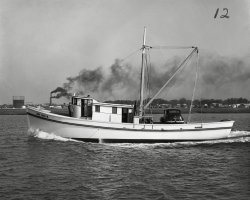
- GLEW: 1906
- ... Works to parties whose names are not given. The boat is now being fitted out at the Ecorse yard for use in the package freight ... Posted by Dave - 08/14/2012 - 2:11pm -
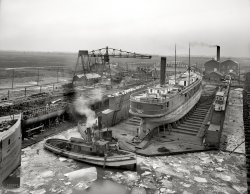
- Baltimore, U.S.A.: 1943
- ...
Did Not Live Long Torpedoed here in 1943 by a U boat. No casualties though.
Charm City Love the picture. I cherish every ... Posted by Dave - 07/29/2019 - 10:34am -
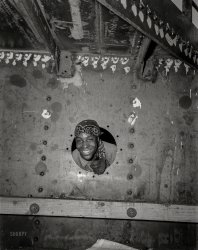
- On the Ohio: 1905
- ... City The steamer Tell City, advertised on the wharf boat, sank in 1917. Her beautiful wheelhouse is on display at the Ohio River ... Posted by Dave - 12/05/2012 - 5:12pm -
![On the Ohio: 1905 The Ohio River circa 1905. "The levee -- Louisville, Kentucky." This barge was last seen here; the large barrel-like containers are hogsheads of tobacco. At left, the bow of the sternwheeler Georgia Lee in a continuation of this view. 8x10 inch dry plate glass negative, Detroit Publishing Company. View full size.
Spirit of Kentucky?Nevermind the hogsheads of tobacco -- is that Kentucky Bourbon in the barrels all the way over on the right?
Flapping flagNo official nine-stripe design ever existed as a US flag, ensign, or jack. In an enhanced version of the photograph, it is possible to see relatively clearly that the star field is made up of pairs of rows with eight stars in one row and an uncertain number in the other. The 1896-1908 official flag was current at the time of the photograph and had 45 stars in alternating rows of eight and seven. A ghost image of the star field is visible to our right of the obvious one, and the light and dark stripes both show narrow ghost strips of the opposite brightness.
I'm fairly certain the flag's appearance is an artifact of the flag moving as the photograph was taken. It's flapping in 10 knot or so wind, and the relatively slow shutter speed caused the image to be blurred, giving the impression of only nine stripes.
[Note this enlargement: it doesn't appear that any of the stripes are fully obscured, much less four of them. The slight blurring of the boy walking down center indicates an exposure time of no more than about 1/25th of a second, if that. - tterrace]
Stars & Nine StripesThe paddlewheeler Glenmore appears to be flying a rather rare flag.
Tell CityThe steamer Tell City, advertised on the wharf boat, sank in 1917. Her beautiful wheelhouse is on display at the Ohio River Museum, Marietta OH, next to the coal fired steam towboat W. P. Snyder Jr.
Well worth the visit.
Re: Stars & Nine StripesI believe it is what they used to call a Sea Captain's Flag, and the design dates back to the revolution.
HogsheadsSo those are hogsheads. Mark Twain described Huckleberry Finn sleeping in a "hogshead." I always wondered exactly what one looked like. Looks roomy.
Fly the flagInfo on 9 stripe flag here http://www.jeffbridgman.com/inventory/index.php?page=out&id=3
Very interesting, things I did not know, but hey I'm English so a bit out of my remit, one is never to young to learn though
(The Gallery, Boats & Bridges, DPC, Louisville)](https://www.shorpy.com/files/images/SHORPY_4a10069a.thumbnail.jpg)
- Onem, Jack and Jesse: 1917
- ... Wickes Hine. View full size.
Algonquin A U Boat sank an American steamer called the Algonquin on 14-March-1917. This must ... Posted by Dave - 05/04/2018 - 11:33am -
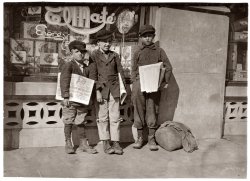
- Parking Brake? Check.
- Working on Catalina flying boat at the Corpus Christi Naval Air Base. August 1942. View full size. ... Posted by Dave - 12/09/2007 - 6:12pm -
![Parking Brake? Check. Working on Catalina flying boat at the Corpus Christi Naval Air Base. August 1942. View full size. 35mm Kodachrome transparency by Howard Hollem.
Parking break?What the person's looking into is probaly the throttle control cables for the engine to get the right setting for speed control.
[Well you know that was a joke. Ha ha! It's a seaplane. And the thing that stops a wheel is, to get all technical-jargony, a brake, not a "break." - Dave]
The PlaneIs a PBY Catalina.
Catalina PBYThese planes are still in use as water bombers for firefighting. They were the long distance and endurance champs of the day when equipped with extra tanks. An interesting read on them is "The Sky Beyond" by Sir Gordon Taylor.
OK, it's your turnHe appears to be buttoning-up the access panel after having successfully started the engine using the hand cranked inertia starter. The crank handle has been passed down to the next recruit. Probably a training exercise, all under the watchful eye of the old man in the back.
(The Gallery, Aviation, Howard Hollem, WW2)](https://www.shorpy.com/files/images/1a34915u.thumbnail.jpg)
- Role Model: 1924
- ... us to the Mainland," he says, "then when we arrived by boat and out of shape, we had to beat all comers on the West coast, again in ... Posted by Dave - 07/25/2012 - 3:05pm -
![Role Model: 1924 August 7, 1924. "Warren Kealoha, Hawaiian Olympic swimmer, at Tidal Basin." Warren, closest to the camera, won the gold in the men's 100-meter backstroke in 1920 and 1924. National Photo Company glass negative. View full size.
Kealoha Obit Washington Post, Sep 10, 1972
Olympic Champion Warren Kealoha Dies
HONOLULU, Sep 9 (AP)--Warren D. Kealoha, 69, winner of gold medals in the 100-meter backstroke swimming event at the 1920 and 1924 Olympic Games, died Friday.
Mr. Kealoha, then 16, introduced the alternating arms stroke in setting a world's record 1:14.8 in the backstroke event as the "baby" of the U.S. Olympic team in 1920 at Antwerp Belgium.
Yell Them To SafetyI guess that lifeguard with the blow horn would have to undo his bow tie if he ever had to actually dive into the water to save someone. I think he would rather just yell them to safety.
Help, HelpFunny seeing that hand sticking up out of water at the left.
Warren KealohaWarren Kealoha retired from competition and became a successful rancher. About those days:
"It wasn't easy for Hawaiians to get to the Olympics back in those days," Warren says, "or I might have had a chance at my third Olympics in 1928." Warren Kealoha had more trouble getting to his races than winning them. "We had to break a world record before they could afford to send us to the Mainland," he says, "then when we arrived by boat and out of shape, we had to beat all comers on the West coast, again in Chicago, and again in New York before we finally made the Olympic team."
Some web pages indicate he swam against contemporary Johnny Weissmuller but the facts seems mixed.
Washington Monument FallingDoesn't it look like the Washington Monument is leaning?
[OMG. Not only that, but the entire horizon is tilting to the right! - Dave]
(The Gallery, D.C., Natl Photo, Sports, Swimming)](https://www.shorpy.com/files/images/26032u1.thumbnail.jpg)
- Transportation Inc.: 1943
- ... Truck drivers like this gentleman, train crews, ship/boat/barge crews and airline crews kept the goods and the people rolling during ... Posted by Dave - 09/18/2013 - 7:43pm -
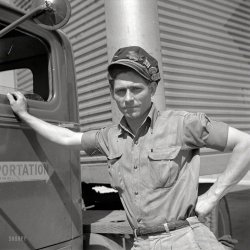
- State of New York: 1910
- ... River Today The two buildings on the right behind the boat are still there. The two large tanks in the distance are where the office ... Posted by Dave - 10/30/2012 - 2:45pm -
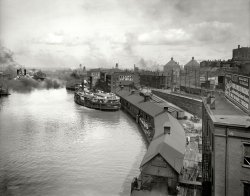
- Beached: 1942
- ...
Hammer and Plug I'd have to guess there is a "Crew" boat nearby. The plug is known as a "Bung". The hammer is used to securely place the "Bung" into the "Bunghole" in the bilge of the boat, lest they sink and join Davey Jones Locker.
Handsome While I know ... Posted by Dave - 04/11/2014 - 4:56pm -
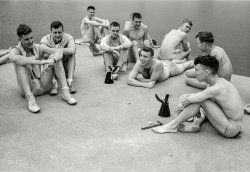
- Trailer Life: 1950s
- ...
From the picture I will infer that Jim also loved boat building, nuts, family and - especially - Lois.
Redundant Lighting? ... Posted by Cazzorla - 09/27/2014 - 10:08am -
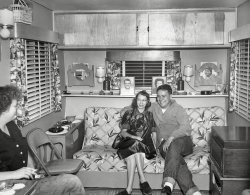
- High Water: 1903
- ... full size.
Grand Picture Like a scene out of Show Boat. Wonderful
If only we could know the cargo As a former merchant ... Posted by Dave - 08/08/2016 - 5:24pm -
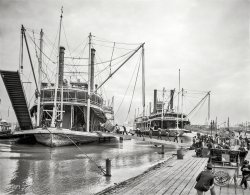
- Fire and Ice: 1900
- ... and cracking, paddlewheels thrashing, a fully loaded boat lurching this way and that as it forces its way through the ice, the steam ... Posted by Dave - 08/13/2012 - 8:19pm -
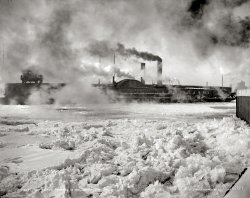
- Railroad Crossing: 1906
- ... sort of trade the Mary Bell was in. Is she a powered boat or a barge? A private houseboat or some sort of commercial floating ... Posted by Dave - 10/01/2013 - 10:50am -
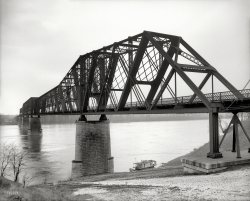
- Après-Launch: 1900
- ... Great Lakes and still happens from time to time, this ore boat was launched sideways. Very recently from the looks of things and all the ... Posted by Dave - 02/26/2015 - 1:24pm -
![Après-Launch: 1900 Sept. 15, 1900. Wyandotte, Michigan. "Freighter Howard L. Shaw in the slip." 8x10 inch dry plate glass negative, Detroit Publishing Company. View full size.
Landfill in TorontoThis freighter made it until 1969 when it was sunk a part of the Ontario Place Landfill in Toronto.
Interesting DateMy grandfather was born 4 months earlier to the day, and served in the US Navy on the USS Olympia C-6, which pre-dates even this old gal.
C'est le FrenchIt seems more like an 'Avant-launch' to me. By the looks of it it hasn't taken to the water yet.
[Look again. - Dave]
Don't omit the punctuationAnother example of the mysterious period at the end of non-sentences in signage. Seems to have flourished until about 1920 or so.
By the way, that steam yacht in the background is lovely. I want!!
Launched sidewaysAs was common on the Great Lakes and still happens from time to time, this ore boat was launched sideways. Very recently from the looks of things and all the water on the ground on the left side. Now most larger boats are built in a dry dock and it's just flooded.
During WWII the Navy was aghast that they would propose launching submarines this way in Wisconsin, but they did, and it worked.
There are some nice videos on Youtube of ships launched this way.
Yeah what's up with that??Doghouse, I have been wondering about that punctuation thing for years -- around here there are old textile mills dating to around 1900 and many have the mystery period on their signage, e.g. "OFFICE." in large carved granite block letters above the entrance. Does anyone anyone anyone know why they would go to the trouble of carving a period there? I'm guessing it was simply the style, but I'd love to learn more about it.
(The Gallery, Boats & Bridges, DPC)](https://www.shorpy.com/files/images/SHORPY-4a05236a.thumbnail.jpg)
- Trip Advisor: 1902
- ... story as to how they got there. Even with the small boat sometimes it's hard to get through. After a big storm there's always trees ... Posted by Dave - 08/15/2011 - 11:12am -
![Trip Advisor: 1902 1902. "Mr. Foster's office in Palm Beach." An outpost of the Ask Mr. Foster chain of travel agencies and souvenir shops started in Florida by Ward Foster in the 1880s. 8x10 glass negative by William Henry Jackson. View full size.
Ocklawaha?Where the heck is Ocklawaha? I might buy a ticket just to find out.
[It is both a town and a river. - Dave]
Philip Morris ain't hereAt first glance, I thought the boy was dressed in a red bellhop uniform like those who used to page people with phone messages at hotels i.e. "Call for Philip Morris!" but on closer inspection he seems to be a messenger or junior assistant of some sort. Also, just think, 109 years ago, somebody cut some lily of the valley out of their garden in the morning and put them in a water glass on their desk and still today they convey the beauty and fragrance of nature, my mom's favorite flower. The posters, postcards, travel photos, etc. pictured would today get you on TV in the Antiques Roadshow and be worth a hefty sum too. Carry on.
A room loaded with Shorpy fruitLook at those walls full of photos and those stacks of big brochures (or whatever travel agencies used then). One of the eye catchers for sure is the Ocklawaha Steamer Tickets sign (part of one was used for a window sign of some kind). A photo like this is why Google was invented, sort of, where I found some marvelous prose:
St. Johns and Ocklawaha Rivers
(Highways and Byways of Florida, 1918)
Palatka is the starting-point of the Ocklawaha steamers. They go south twenty-five miles, then turn west and enter the old forests of the "dark crooked water," which is what the name of the stream means in English. The journey ends at Silver Springs, one hundred and ten miles farther on. Enthusiasts call the Ocklawaha "the sweetest water-lane in the world," and the voyage through this liquid silent forest aisle is full of weird interest. Certainly no trip to Florida is complete which does not include an outing on this romantic stream with its ever-changing scenes and its tonic air laden with the balsamic odors of the forest.
The latter part of the Ocklawaha journey is made at night, and it is then that the river is seen most impressively after a fire of pine knots has been kindled in a big iron box on the top of the pilot-house. This blazes finely, and the light from the resinous yellow flames advances up the dark sinuosities of the stream in a manner that is enchantingly mysterious. The foliage which it touches is magically green, the festooning mosses are transformed to silvered garlands, the tree trunks turn to corrugated gold, and the black slimy stumps become jeweled pillars. When the fire dies down a little the distant scenery becomes indistinct and shadowy, and the great trees are pallid and ghostly. Then fresh knots are thrown in, the fire blazes up, and again the winding forest walls are brightly lighted amid the impenetrable surrounding mirk, while everything is reflected in the smooth water.
Ocklawaha and Silver RiversAs a photographer I wish I could go back in time and visit this place. I live near the Ocklawaha and Silver Rivers. They haven't changed much since the old days. Here is the Ocklawaha River today.
Here's the Silver River which starts at Silver Spring and flows into the Ocklawaha.
I fell in love with these rivers about 12 years ago and started photographing the flora and fauna. There is a high concentration of wildlife on these two rivers including rhesus monkeys which in itself is an interesting story as to how they got there. Even with the small boat sometimes it's hard to get through. After a big storm there's always trees blocking the rivers and in the old days they must have had a crew working full time to keep the waterway clear.
[One would be hard pressed to tell them apart. - Dave]
Hand Painted Art for sale Ah, hand coloring a black and white photograph. That is a lost art these days. Very few, if any photographers have the time or patience to sit down with a picture and a large box of watercolor type paints with which to hand color a photograph.
I used to do hand spotting of photos and that was hard enough matching the gray-tones to the photo.
Now it is all computerized as displayed on Shorpy.com. We have some artists who excel at digitally colorizing photographs, such as Don W.
Timeshift"Hedonism? Well! Certainly not, Sir!"
(The Gallery, Florida, The Office, W.H. Jackson)](https://www.shorpy.com/files/images/4a20521a.thumbnail.jpg)
- Queens of Comedy: 1919
- ... picture.
The girl with the paddle could row my boat any day. I'll bet the other girls called her "Skinny".
Original ... Posted by Dave - 06/30/2020 - 12:09pm -
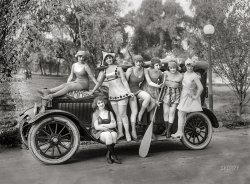
- The Old Basin: 1906
- ... not sure if the lugger referred to pertains just to the boat or to the kid with the burlap sack.
[The charcoal (and oyster) ... Posted by Dave - 08/21/2012 - 10:49am -
![The Old Basin: 1906 New Orleans circa 1906. "Charcoal lugger in the Old Basin." 8x10 inch dry plate glass negative, Detroit Publishing Company. View full size.
That's MY CigarThat kid kneeling on the right looks he really wants that cigar. Either that, or he just had it taken from him.
Schr. Mabel E. Judlin
from A History of Vancleave, Mississippi,
by Ray L. Bellande.
Miss Mabel Judlin was the namesake of another trading schooner, the Mabel E. Judlin. This vessel was constructed at Handsboro by Matteo Martinolich (1861-1934) in 1891, for J.L. Mestier & Company of New Orleans.
The Mabel E. Judlin was 67 feet long, had a beam of 22 feet, and hold depth of 4 feet. Her sails were constructed by A. Gerdes & Brother of New Orleans. (The Biloxi Herald, May 2, 1891, p. 4, c. 2) The Mabel E. Judland (sic) was reputed to be the fastest schooner in the entire Gulf and Caribbean. She hauled charcoal from the banks of Bluff Creek when owned by James E. Lockard (1862-1951) of Vancleave. The fledging United Fruit Company used the Mabel E. Judland (sic) as a model for their shallow draft fruit boats. (Down South, July-August 1960, p. 9)
What Catches My EyeThe schooner Mabel E Judlin is hardly the elegant sort of craft that Canadians think of when we think of schooners. The Bluenose would turn up her nose at this example of the type.
What really catches my eye about this photo is the fellow, who can't be too far into his teens if he's even made it that far, with the sack over his back and his cigar at a jaunty angle. Looks like he could whup his weight in wildcats and not disturb the ash from that stogie.
What's in a name?I'm still not sure if the lugger referred to pertains just to the boat or to the kid with the burlap sack.
[The charcoal (and oyster) luggers are the boats. - Dave]
(The Gallery, Boats & Bridges, DPC, New Orleans)](https://www.shorpy.com/files/images/4a13313a.thumbnail.jpg)























